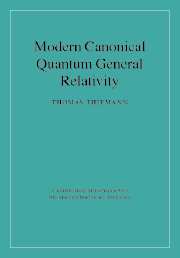Book contents
- Frontmatter
- Contents
- Foreword, by Chris Isham
- Preface
- Notation and conventions
- Introduction: Defining quantum gravity
- I CLASSICAL FOUNDATIONS, INTERPRETATION AND THE CANONICAL QUANTISATION PROGRAMME
- II FOUNDATIONS OF MODERN CANONICAL QUANTUM GENERAL RELATIVITY
- III PHYSICAL APPLICATIONS
- IV MATHEMATICAL TOOLS AND THEIR CONNECTION TO PHYSICS
- References
- Index
Introduction: Defining quantum gravity
Published online by Cambridge University Press: 04 August 2010
- Frontmatter
- Contents
- Foreword, by Chris Isham
- Preface
- Notation and conventions
- Introduction: Defining quantum gravity
- I CLASSICAL FOUNDATIONS, INTERPRETATION AND THE CANONICAL QUANTISATION PROGRAMME
- II FOUNDATIONS OF MODERN CANONICAL QUANTUM GENERAL RELATIVITY
- III PHYSICAL APPLICATIONS
- IV MATHEMATICAL TOOLS AND THEIR CONNECTION TO PHYSICS
- References
- Index
Summary
In the first section of this chapter we explain why the problem of quantum gravity cannot be ignored in present-day physics, even though the available accelerator energies lie way beyond the Planck scale. Then we define what a quantum theory of gravity and all interactions is widely expected to achieve and point out the two main directions of research divided into the perturbative and non-perturbative approaches. In the third section we describe these approaches in more detail and finally in the fourth motivate our choice of canonical quantum general relativity as opposed to other approaches.
Why quantum gravity in the twenty-first century?
It is often argued that quantum gravity is not relevant for the physics of this century because in our most powerful accelerator, the LHC to be working in 2007, we obtain energies of the order of a few 103 GeV while the energy scale at which quantum gravity is believed to become important is the Planck energy of 1019 GeV. While that is true, it is false that nature does not equip us with particles of energies much beyond the TeV scale; we have already observed astrophysical particles with energy of up to 1013 GeV, only six orders of magnitude away from the Planck scale. It thus makes sense to erect future particle microscopes not on the surface of the Earth any more, but in its orbit. As we will sketch in this book, even with TeV energy scales one might speculate about quantum gravity effects in the close future with γ-ray burst physics and the GLAST detector.
Information
- Type
- Chapter
- Information
- Modern Canonical Quantum General Relativity , pp. 1 - 36Publisher: Cambridge University PressPrint publication year: 2007
